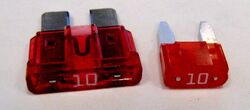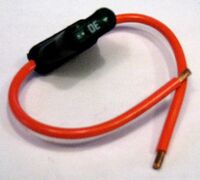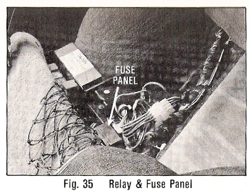All of the fused circuits are routed through the fuse box located in the relay compartment behind the passenger seat. There are 17 fuses in use, and one spare, in the fuse box[1]. The radio also has two inline fuses which are located at that unit.
Fuses[]

Common ATO-style automative fuses for various amperages.

A full-size ATO and mini automotive fuse, 10 amps. Mini fuses are used in some aftermarket DeLorean additions, such as the Lockzilla keyless entry module.
The DeLorean uses standard "ATO"-style two-terminal automotive fuses. Fuses are rated in amps, and can be identified by their rating through their color and the white number clearly displayed on the top edge. The fuses body is a plastic housings with two metal blade-style connectors on one end. A window on the front of the fuse makes it fairly simple to tell if a fuse is blown by checking to see if the metal "S" or zig-zag within is intact. Fuses can also be tested via the two exposed metal contacts flaking the numerical amperage rating on the top of the fuse.
More information about automative fuses can be found on Wikipedia, including photographs and common color codes.
Fuse Box[]
As mentioned above, the fuse box is located behind the passenger seat. It is accessed by removing the carpet on the parcel shelf and lifting out the plywood access cover. The cover of the fuse box is labeled with the function of the fuses.
Troubleshooting[]
Checking and Replacing Fuses[]
If any part of the car's electrical system fails to function, a good first place to look is the fuse box. The cover of the fuse box, the chart below, the Owners Manual and the DeLorean Owners Manual can help you find which fuse is used for which function. Pull the appropriate fuse and check the window to see if the metal is intact. If it is missing or burned through, then the fuse is needs to be replaced. Pliers can be helpful when removing fuses.
Always replace blown fuses with those of similar ratings. Using a fuse smaller than the actual operating load of circuit will cause it to blow immediately, while using too large of fuse may keep it from blowing when it should. Fuses should never be bypassed with a piece of wire or other metal, as this can destroy the component the fuse protects, or start a fire by putting more amperage through the wires than they can take.
Intermittent Operation[]

An inline fuse holder with a 30 amp ATO fuse installed. Inline fuses are commonly used to fuse aftermarket modifications and to bypass bad fuse sockets in the fuse box.
If you have intermittent operation of an electrical component, it may be due to a bad fuse contact. This can sometimes be spotted by wiggling the fuse in the holder, causing the circuit to temporarily come to life. Often the fuse box has melted due to heat, or a wire has become damaged at the holder. Simply replacing the fuse won't fix this problem.
An interim solution is to jump around the fuse. After disconnecting the battery, you need to lifting the fuse box so you can get access to the wires underneath. Unfortunately, the wires are quite short, so the holder cannot pulled out very far. You can cut the two wires that go to that fuse, and splice in an inline fuse holder from an auto parts store.
A more permanent solution is to replace the fuse box.
Constantly Blowing Fuse[]
A fuse that continually blows out can be caused by a short in the system or dirty fuse contacts.
A short to ground my be intermittent, causing the fuse to blow out occasionally. The only way to fix this is to trace the wires looking for bad connections.
Dirty fuse contacts on fuses or relays and damaged can increase the resistance by requiring the same amount of power to pass through a smaller area. This increases the amperage in the circuit, possibly to the point of exceeding the fuse rating and thus blowing the fuse. Cleaning various contacts may help, including the fuse socket, relay sockets, and any screwed-down or plug-in wires, including grounds on the frame.
Hot Fuses and Melted Fuse Box[]
Excessive heat from the fuses can cause the plastic fuse box to melt. This is most often an issue for the for the headlight fuse. The heat causes the fuse box to soften and warp, spreading the contacts so that the fuse slips. It may be difficult or impossible to get the fuse to sit securely in the socket once this has occurred. The melted socket can be bypassed with an inline fuse holder as described above, but the best solution is to replace the fuse box with a new one.
A common cause for hot fuses is dirty or loose fuse sockets. This increases the resistance and thus produces more heat. Cleaning the fuse socket and slightly bending the contacts to improve the connection may help reduce the heat. See also the alternate fuse ratings section below about using alternate fuses for select circuits in specific conditions to reduce fuse temperature.
Replacing the Fuse Box[]
The fuse box can be replaced with a new one. Various DeLorean vendors carry improved fuse boxes with larger terminals to reduce heat. Special T Auto also sells an alternative, heavy-duty fuse box. It takes between three and six hours to replace the fuse box. It isn't so much difficult as it is tedious, as a total of thirty four wires need to be routed from the old box to the new.
Stainless DeLorean on DMCTalk has detailed how to replace the fuse box with an upgraded DeLorean one. He lists the various tools needed not only to remove the existing fuse box, but to repair and splice any damaged wires you may encounter. For improved access, he also removed the passenger seat. He takes great care to keep track of the wires to ensure that everything is wired properly into the new box.
Fuse Ratings and Function Table[]
The Workshop Manual[1] and Owners Manual[2] give different descriptions for which circuits are protected by each fuse, although they are consistent with each other. For completeness, both sets of information are listed below.
Fuse Ratings[]
The diagram below lists the original fuse ratings that shipped with the car. These can be found in the Workshop Manual and Owners Manual.
| Fuse Number | Factory Rating (Amps) | Supply | Circuit Protected (Workshop Manual)[1] |
Circuit Protected (Owners Manual)[2] |
|---|---|---|---|---|
| 1 | 10 Amps (red) |
From Ignition II | RPM relay Distributor vacuum solenoid Ignition ECU Idle speed ECU. |
Warm up regulator Ignition control unit Idle speed regulator |
| 2 | 10 Amps (red) |
Only supplied when light switch operated | Left tail lamp Side lamps Front parking lamp License plate lamp |
LH taillight LH rear side marker LH license plate LH front side marker LH Front Parking Light |
| 3 | 10 Amps (red) |
From Ignition II | Windshield wiper Washer motors |
Windshield wiper Windshield washer |
| 4 | 20 Amps (yellow) |
From Ignition II | Directional indicator switch Stop light switch |
Direction indicators Turn signal lamps |
| 5 | 10 Amps (red) |
From Ignition II | All dash instruments and indicators Service interval counter Cool fan relay Voltage regulator "charge" lamp circuit |
Lambda service counter Seat belt warning light Door ajar warning light Temp. gauge Oil pressure gauge Fuel gauge Oil, battery fuel, brake warning lights Voltmeter Tachometer Radiator cooling fans control |
| 6 | 20 Amps (yellow) |
Permanently live | Hazard warning switch Horns Buzzer logic box |
Stop lamps Horns Headlamp flashing switch Buzzer logic box Hazard warning lamps |
| 7 | 20 Amps (yellow) |
Permanently live | Lambda relay Lambda ECU Frequency valve Fuel pump Control pressure regulator |
Lambda control unit Fuel pump |
| 8 | 10 Amps (red) |
Only supplied when light switch operated | Right tail lamp Side lamps Front parking lamp License plate lamp Cigar lighter lamp Instrument panel illumination lamps main light switch lamp hazard warning switch lamp and digital clock lamp |
Cigar lighter illumination RH license plate RH tail lamp RH rear side marker RH front park light RH front side marker Instrument illumination Clock dimmer |
| 9 | 10 Amps (red) |
From Ignition I | Heated rear window electric mirrors |
Heated rear window Door mirrors |
| 10 | 20 Amps (yellow) |
From Ignition I | A/C mode switch Door lock warning lamp |
Lock doors warning light Fan speeds 1 & 2 Fan speeds 3 & 4 control Air conditioning compressor |
| 11 | 30 Amps (green) |
From Ignition I | Radio clock Gear selector lamp A/C panel lamps Power windows |
Gear illumination (automatic transmission) Door windows Air conditioning panel illumination Radio display Clock illumination |
| 12 | 10 Amps (red) |
Permanently live | Diagnostic plug Engine compartment lamp Luggage compartment lamp Glove box lamp Door lamps Interior lamps Interior lamp delay unit |
Door lamps Rear interior lamp Front interior lamp Glove box lamp Luggage compartment lamp Engine compartment lamp Engine diagnostics |
| 13 | 10 Amps (red) |
From Ignition I | Automatic transmission | Automatic transmission |
| 14 | 20 Amps (yellow) |
Supplied when low beam is switched | Low-beam headlamps | Low beam |
| 15 | 20 Amps (yellow) |
Supplied when high beam is switched | High-beam headlamps | High beam |
| 16 | 10 Amps (red) |
From ignition I | Reverse lamps | Back-up lights |
| 17 | 20 Amps (yellow) |
Permanently live | Cigar lighter Clocks |
Cigar lighter Clock supply Radio supply |
| 18 | 20 Amps (yellow) |
Spare fuse |
Inline Fuses[]
These inline fuses are attached directly to wires on the radio.
| Rating (Amps) | Circuit Protected/Location |
|---|---|
| 1 Amp (black) |
Radio purple wire. |
| 5 Amp (brown) |
Radio light green wire. |
Alternate Fuse Ratings[]
The above table includes the factory-recommended DeLorean fuses. Elvis, an electrical engineer on DMCTalk, found a [discussion on the german DeLoreans.de forum that determined the standard high beam, low beam and stop light fuses run very close to their maximum limits. This causes the fuses to get very hot, over 300° C in some cases. Replacing these fuses with slightly higher ratings drastically reduces the heat dissipated and increases the life of the fuse box.
It is believed that this is directly dependent on the headlights you have installed. Cars using the factory sealed beam headlights draw less power than those upgraded to H4 halogen bulbs, as is common in Europe and may have been done by owners in the US to get brighter lights. Note that all sealed beam lights are not immune, Silvania Silverstar bulbs draw 55 to 65 watts as well[3].
It is important to note that this may be less of an issue for owners with the original DeLorean headlights rated at around 40 watts. Aftermarket headlights may draw 55 to 65 watts, putting a greater strain on the electrical system and driving the fuses closer to their failure points. This increases the heat and may melt the fuse box. This is especially true for european DeLoreans, as they are required to use the higher-wattage H4 halogen bulbs in place of the factory-installed sealed-beam units used in the US[4].
The stop light fuse and Lambda/fuel pump fuse were also found to run hot at times, and so this is also included in the alternate fuse table below.
Not that you should NOT simply replace any hot fuse you find with a higher rated fuse, as this may be dangerous. Always use properly rated fuses, as described above. These specific replacements are believed to be safe, but other replacements may be dangerous and can damage the DeLorean's electrical system if not done properly.
| Fuse Number | Original Rating (Amps) | Alternate Rating (Amps) | Supply | Circuit Protected (Workshop Manual)[1] |
Circuit Protected (Owners Manual)[2] |
|---|---|---|---|---|---|
| 6 | 20 Amps (yellow) |
25 Amps (clear/natural) |
Permanently live | Hazard warning switch Horns Buzzer logic box |
Stop lamps Horns Headlamp flashing switch Buzzer logic box Hazard warning lamps |
| 7 | 20 Amps (yellow) |
25 Amps (clear/natural) |
Permanently live | Lambda relay Lambda ECU Frequency valve Fuel pump Control pressure regulator |
Lambda control unit Fuel pump |
| 14 | 20 Amps (yellow) |
25 Amps (clear/natural) |
Supplied when low beam is switched | Low-beam headlamps | Low beam |
| 15 | 20 Amps (yellow) |
25 Amps (medium draw headlights) (clear/natural) 30 Amps (high draw headlights) (green) |
Supplied when high beam is switched | High-beam headlamps | High beam |
Parts[]
- 106912: Fuse Box, original
- 106912N : Fuse Box, improved, with terminals, fuses and cover
- 106913 : Fuse Box, improved, with terminals and fuses
- Special T Auto Fuse Box, alternative heavy-duty design
External Links[]
- Wikipedia article on fuses
See Also[]
References[]
- ↑ 1.0 1.1 1.2 1.3 DeLorean Workshop Manual, M:07:02 - M:07:03
- ↑ 2.0 2.1 2.2 DeLorean Owners Manual, page 43
- ↑ Posed by Bitsyncmaster on DMCTalk in Fuse box and fuse ratings
- ↑ Posted by Elvis in Fuse box and fuse ratings on DMCTalk
